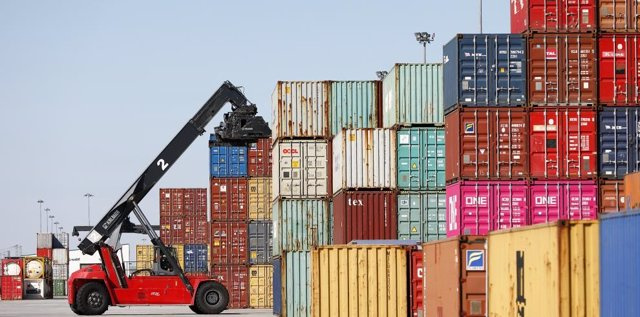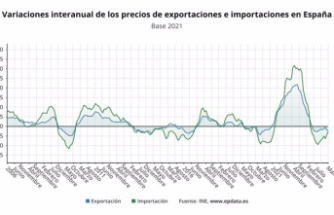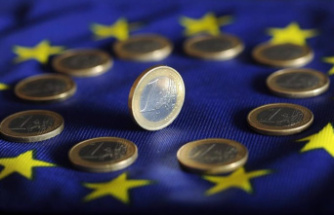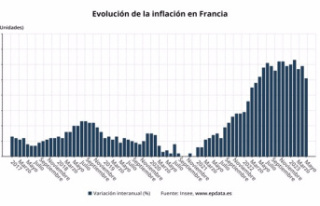The energy deficit fell to 11,640.3 million euros, compared to 16,155.4 million in the same period last year
The trade deficit stood at 10,953.7 million euros in the first four months of the year, which represents a 50% decrease compared to that registered in the same period of 2022, according to data published this Thursday by the Ministry of Industry, Trade and Tourism.
The report on foreign trade for April reflects that the energy deficit in the first four months of this year fell to 11,640.3 million euros, compared to 16,155.4 million in the same period of the previous year, while the balance was not energy yielded a surplus of 686.5 million euros, compared to the deficit of 5,655.6 million in 2022.
EXPORTS GROW 9% AND IMPORTS, ONLY 0.2%
Spanish exports of goods increased by 9.2% up to April over the same period in 2022, with 132,026.3 million euros, a record high for the period. Imports, on their side, rose a slight 0.2%, to 142,980 million euros, also a record high.
In volume, exports remained stable, since their approximate prices by unit value indices also increased by 9.2%, while imports fell by 4.4% year-on-year, due to the fact that their prices rose by 4. 8%
Thus, the coverage rate --quotient between exports and imports-- stood at 92.3%, that is, 7.6 percentage points more than that registered in January-April 2022 (84.7% with provisional data ).
EXPORTS OF GOODS TO THE EU GROWN BY 10.3%
Exports to the EU in January-April 2023 (63.8% of the total) increased by 10.3% compared to the same period of the previous year. In the case of sales to the euro zone (55.9% of the total), they increased by 9.3%, while those destined for the rest of the European Union (7.9% of the total), increased by 17.6 %.
By country, the cumulative increase up to April in exports to Germany (13.9%), Italy (12.6%), France (11.1%) and Portugal (3.2%) stands out. In the rest of Europe, sales to Turkey were up 26.3% and sales to the UK were up 7.4%.
SALES TO ALGERIA CONTINUE TO LOW TO A MINIMUM
On the other hand, exports to third destinations increased by 7.3% year-on-year in this period, and account for 36.2% of the total, highlighting the growth of exports to Oceania (33.9%), Latin America (25% ), North America (9.6%) and Asia excluding the Middle East (1.6%), compared to the declines in the Middle East (-9.7%) and Africa (-2.6%).
By country, the increases in Australia (33.5%), Nigeria (32.5%), Vietnam (29.7%), Brazil (23.9%), Hong-Kong (22.9%), South Africa (18%), Mexico (11.7%), Morocco (11.5%) and the United States (10.4%).
On the contrary, Algeria stood out negatively (-92%) due to the suspension by this country of its Treaty of Friendship with Spain in response to the new position adopted by the Government regarding the Sahara. Exports also fell to Saudi Arabia (-32.3%), Singapore (-12.5%), Japan (-9.6%), South Korea (-6.9%), Canada (-5.2 %), Chile (-1.2%) and Peru (-1%).
GREATER WEIGHT OF EXPORTS OF CHEMICAL PRODUCTS
The main sectors in terms of weight over total exports in the period were chemical products, which represented 18.4% of the total and increased 7.3% year-on-year. They are followed by capital goods (18.1% of the total and up 20.5% year-on-year), food, beverages and tobacco (17.4% of the total and up 9.2% year-on-year) and the automobile sector (13, 4% of the total and increased by 26.5% year-on-year).
The main positive contributions of exports from January to April 2023 came from the capital goods sector (contribution of 3.3 points), automobile sector (3.1 points), food, beverages and tobacco (1.6 points) and chemical products (1.4 points).
On the contrary, the main negative contributions came from the non-chemical semi-manufactured sectors (contribution of -0.4 points), energy products (-0.3 points) and raw materials (-0.2 points).
Regarding imports, the main positive contributions in the January-April period came from the automotive sector (2.5 points), capital goods (2.4 points), food, beverages and tobacco (1.6 points) and other goods (0.1 points).
On the contrary, the largest negative contributions came from the energy products sector (contribution of -3.4 points), chemical products (-1.9 points), non-chemical semi-manufactures (-0.9 points) and durable consumer goods (- 0.2 points).
THE BALEARIC ISLANDS REGISTERED THE LARGEST INCREASE IN ITS EXPORTS
By autonomous community, the community that experienced the highest interannual variation rate of its exports in the period was the Balearic Islands (23.6%), followed by La Rioja (21.0%) and Castilla y León (20.2%). On the other hand, exports from the Canary Islands (-25.5%), Andalusia (-4.8%) and the Foral Community of Navarra (-3.3%) fell.
In the analysis of the contributions to the interannual variation rate of total exports (9.2%), the Community with the greatest positive contribution was Catalonia, with 4.4 percentage points, whose exports represented 26.4% of the total and grew by 18.1% year-on-year. It was followed by the Community of Madrid, with a contribution of 1.6 points and whose exports, 14.5% of the total, increased by 11.2% year-on-year.
The Communities with the greatest negative contributions were Andalucía with -0.6 points (10.2% of total exports, fell 4.8% year-on-year) and Canarias with -0.2 points (0.6% of the total, decreased 25.5% year-on-year).













